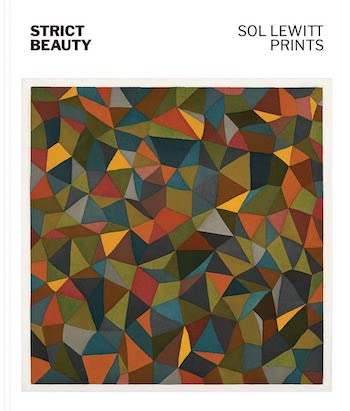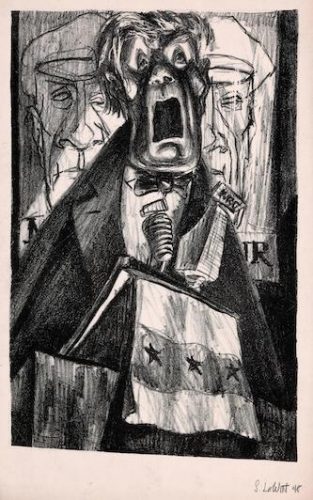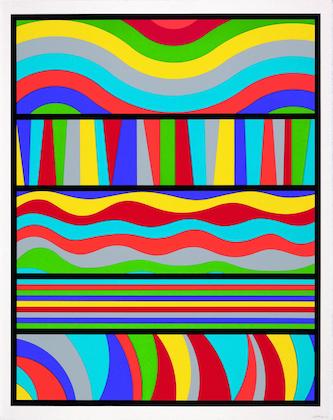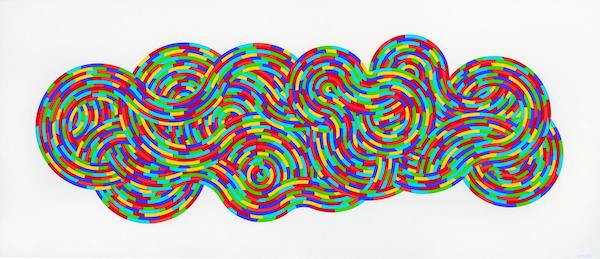Visual Art Review: The Enigma of Sol LeWitt
By Charles Giuliano
Strict Beauty: Sol LeWitt Prints is a compelling opportunity for immersion in an important aspect of the artist’s work
Strict Beauty: Sol LeWitt Prints, at the Williams College Museum of Art, Williamstown, through June 11.
“In conceptual art the idea or concept is the most important aspect of the work. When an artist uses a conceptual form of art, it means that all of the planning and decisions are made beforehand and the execution is a perfunctory affair. The idea becomes a machine that makes the art” Sol LeWitt, writing in Art Forum in 1967.
 Sol LeWitt (1928-2007) is regarded by critics as one of his generation’s most innovative abstract/conceptual artists. He died just months before the opening of a retrospective of 105 large wall drawings in December 2007. They were created by technicians according to his instructions. The works now occupy a three-story building on the campus of MASS MoCA where they will be on view for twenty five years. Recently, some of the works have been refreshed.
Sol LeWitt (1928-2007) is regarded by critics as one of his generation’s most innovative abstract/conceptual artists. He died just months before the opening of a retrospective of 105 large wall drawings in December 2007. They were created by technicians according to his instructions. The works now occupy a three-story building on the campus of MASS MoCA where they will be on view for twenty five years. Recently, some of the works have been refreshed.
Some of LeWitt’s smaller wall drawings were intended to be temporary, but many museums have opted to make them permanent, most recently the Williams College Museum of Art. Strict Beauty: Sol LeWitt Prints is a compelling opportunity for immersion in this aspect of the artist’s work. Examining the drawings on a more intimate scale will give you a grounding, a useful perspective, that will assist in appreciating the range of LeWitt’s singular and daunting oeuvre, which can be viewed, considerably expanded, on the MASS MoCA campus.
LeWitt was a prolific printmaker, generating some 350 projects in editions that contain thousands of prints. This interest began at Syracuse University, where he took a lithography course three times. He went on to explore many media, including silkscreens, etchings, aquatints, woodcuts, and lino cuts. The WCMA exhibit is made up of single sheets and print series, displaying a total of over 200 individual prints. Curated by David S. Areford, professor of art history at the University of Massachusetts Boston, this is the most comprehensive survey of LeWitt’s prints to date. Areford has organized the work by themes: “Lines, Circles and Grids,” “Bands and Colors,” “From Geometric Figures to Complex Forms,” and “Wavy, Curvy, Loopy Doopy and in All Directions.”

Sol LeWitt’s Untitled (Politician) on display in Strict Beauty: Sol LeWitt Prints at WCMA. Photo: Williams College Museum of Art.
The earliest works are expressive of the social realist and regionalist styles of the late ’40s. After graduation, LeWitt needed to work. He had little time for making art. In 1970, he started printmaking with Crown Point Press, going on to collaborate with other printers and technicians. At times, he worked directly on plates or had his drawings and designs transferred to print media. Early on these prints were created according to his specific instructions — “the idea becomes a machine that makes the art.” LeWitt’s plans for his prints, which museums and collectors own the rights to, have been compared to musical scores. But fabricators do not have the latitude of conductors. Note that emphasis on automation. Still, Areford “doth protest too much” when he feels it is essential to convey, in excruciating detail, the precise program, instructions, and technical intent of every print on view. This approach bypasses the study of iconography in art history, which was dedicated to explicating the meaning of every symbolism in a work of art. There is, however, no meaning in the non-objective works of LeWitt. Some images, particularly when they are boldly geometric, stridently graphic or brightly colored, were intended to make an immediate and visceral impact. The more opaque images are more difficult to connect with.
When LeWitt abandoned his juvenilia of figuration, he did not pass through abstraction, but progressed to non-objective art. The pioneering artists, Picasso, Duchamp, and Mondrian evolved from representation to an abstracted view of nature. Jackson Pollock declared “I am nature.” By the time of LeWitt’s generation, artists bypassed those intermediary steps.
In a sense, he started with the Suprematism of Kasimir Malevich. In general, Minimalism (the term was never used by the artists) challenged the sanctity of hand-made objects, the role of the art market, the power of empathy, and traditional conventions of aesthetic appreciation. These ideas have become second nature to today’s students, who are emerging from ever more theoretical fine arts programs. [For additional background, consult Areford’s in-depth catalog for the exhibition, co-published by the New Britain Museum of American Art, Williams College Museum of Art, and Yale University Press. Also recommended: the dissection of LeWitt and his aesthetic by Kenneth Baker in his seminal 1988 book Minimalism, which is particularly good on the artist’s architectonic structures.]

Sol LeWitt’s Lincoln Center Print, on display in Strict Beauty: Sol LeWitt Prints at WCMA. Photo: Williams College Museum of Art.
There are essentially two ways to approach the WCMA exhibition. One might read each wall label and study the images or sweep through the exhibition to make it an absorbing visual experience.
Living close to the museum, I enjoyed indulging in both approaches. For the first visit, I focused on moving from the general to the specific. I read the catalogue and then returned to read the labels before I studied each print individually. The greatest joy in this exhibition is that it gives you the opportunity to follow the artist’s thought process (as it were), from point, to line, to square. There is a wealth of rewarding approaches. Another story arc: move from the tentative, groping, initial works to the ever more passionately explosive and complex later ones.
An interesting midpoint LeWitt work is “Shul Print (Six Pointed Star)” from 2005. It acknowledges his Judaism (he helped to design his local temple) while it also alludes to the small squares of color in the late Mondrian painting “Broadway Boogie Woogie” (1942).
In the final gallery, a broad wall displays “Brushstrokes in Different Colors in Two Dimensions,” 1993. They resemble Morris Louis’s vertical stripes. The same uncanny energy can be found in “Wavy Lines (gray) and Wavy Lines (color),” 1995. The latter could be a meditation on the Futurism of Gino Severini and Giacomo Balla.

Sol LeWitt’s Whirls and Twirls (Color), on display in Strict Beauty: Sol LeWitt Prints at WCMA. Photo: Williams College Museum of Art.
I plan to visit the exhibition again with a poet friend. Together I hope that, with considerable pleasure, we may unpack the enigma of Sol LeWitt.
Charles Giuliano has published his seventh book, Museum of Fine Arts, Boston: 1970 to 2020 an Oral History. He publishes and edits Berkshire Fine Arts.
Tagged: Charles Giuliano, Sol LeWitt, Strict Beauty: Sol LeWitt Prints

Terrific review of LeWitt. Very clearly written and engaging. I must say that artists like Sol LeWitt grew on me as I got older. It was interesting to see the comparison between LeWitt’s early political piece that had a kind of Constructivist armature and his later almost musical color piece. Underpinning connection.